As we do for every one of our tours, we scout all possible locations to determine what the best combination of cat sightings, location accessibility, accommodations, food, and guides are. We went to Estonia to check it out as a possible tour location for Eurasian lynx. It was a highly successful tour and we are now offering a Eurasian lynx tour on an annual basis. Read our Eurasian lynx of Estonia Photo Tour 2025 Trip Report to find out all the details of our sightings.

Highlights of the 2025 Eurasian Lynx of Estonia Photo Tour
Eurasian Lynx: We photographed 5 different Eurasian lynx, including a mother and her close to fully grown kitten during the daytime. The resounding highlight however was watching that same mother and kitten first stalk a mountain hare at night time for over an hour, and then doing something totally unexpected (read the story on day 6). Our closest sighting was at ten meters, for over fifteen minutes. Most of our sightings occurred at night.
Mammals: We saw 11 mammal species. In addition to the Eurasian lynx, we saw quite a few other carnivores, including Eurasian badger, golden jackal, red fox, and the unique looking raccoon dog. Moose, roe deer, were our ungulates, and we all loved seeing the pure white mountain hares on two occasions. There was at least one other mustelid we saw through the thermals, but which disappeared before we could put the spotlight on it.
Birds: We identified 27 different bird species, and had multiple opportunities to photograph Ural owls. We also had a wonderfully close sighting of a northern pygmy owl. Hazel grouse were a fantastic find, and of course the western capercaillie took the price for most impressive bird in the area.
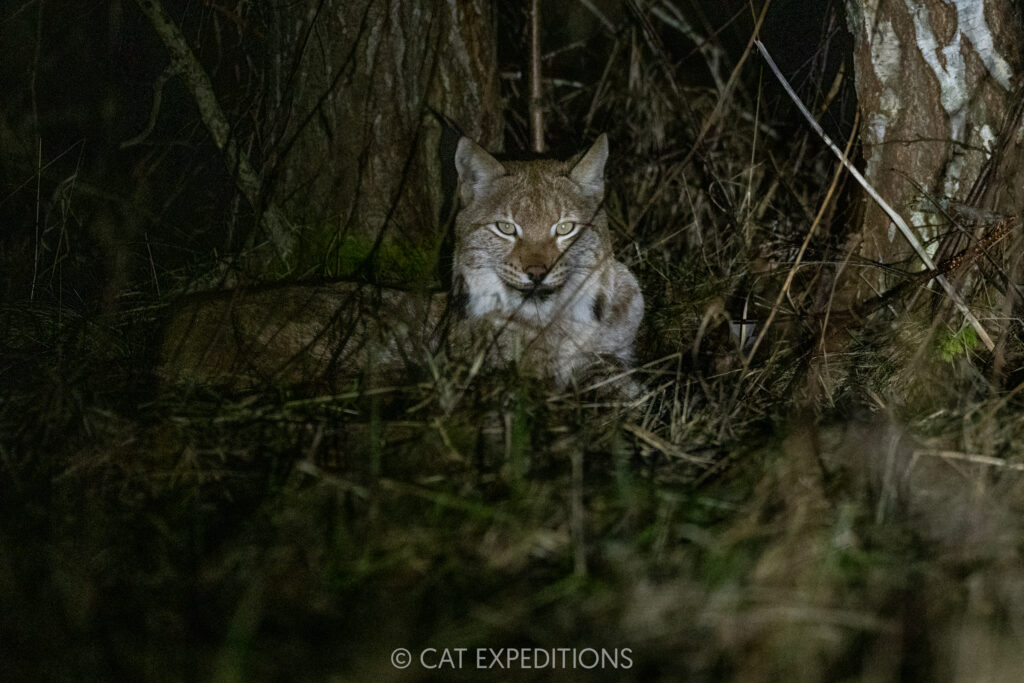
Detailed Eurasian Lynx of Estonia Trip Summary 2025
Day 1: Everyone arrived in Tallinn, Estonia, and made their way to Laheema National Park, where we would be based for our tour. We settled into our two hundred year old manor before getting ready for our welcome presentation. Before we could even get to it, a lynx had been spotted and we rushed to the scene. It was dusk and as we pulled up the lynx jumped down from a stump and disappeared. Some of us got one tiny glimpse of it, minutes later, but it didn’t feel like a true sighting. We felt frustrated to have just missed it, and excited to have had a chance to do so, so quickly. We had dinner and then got into the vehicle to start looking for any cats at nighttime. The first night was filled with roe deer, European hare, and a very rare sighting of a golden jackal. No lynx showed itself however.
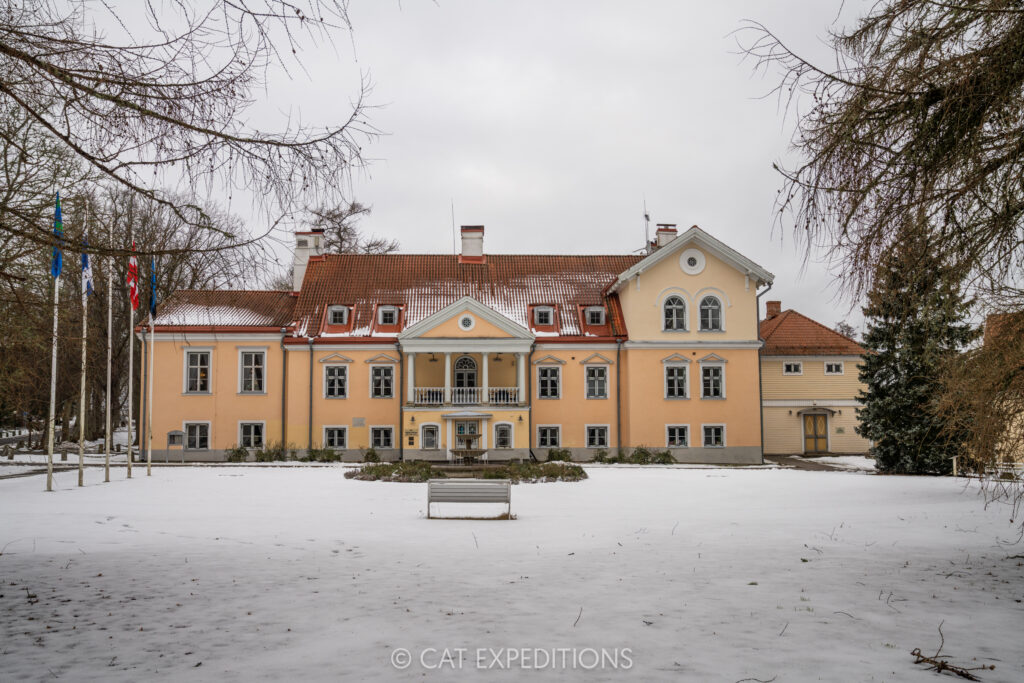
Day 2: We drove through beautiful boreal forests in the morning, and quickly found ourself on the coast. Ice floes were gathering on the shore, which was an impressive sight. We walked around a bit and found some nice raccoon dog tracks on the beach.
After lunch we tracked lynx, walking through some bogs following a female with her kitten. After some time, the tracks led us to a farm house, and we quickly understood why, the remains of a domestic rabbit were surrounded by lynx tracks. A reality in an area where Eurasian lynx and people coexist.
At dusk, we once again got word from a spotter that a Eurasian lynx had been seen. We rushed to the location as fast as we could. Once again, a few seconds before our arrival, the lynx disappeared into the forest. It felt like deja vu. Did the lynx just not like us? Our local guide knew this was a small forest and there was a good chance the lynx would reemerge, so we just waited. It took less than 15 minutes before we picked up the lynx in the thermal. We moved the car into position for a good view, but the lynx was behind thick reeds. We could see it was a lynx, but no photo was possible. We left the car, which in hindsight was a mistake, as the cat retreated. We got back in the car and just waited again. Once again, it emerged from the forest, so we photographed the cat from the car as it was moving along the forest edge. After twenty minutes or so, he stopped, sat down, and started grooming itself. It was so incredible to have the cat so relaxed.
After taking all the photos we could wish for, we left him, wanting to make sure we weren’t disturbing him.
All of us were exhilarated. After the frustration of the prior day, we were all on a sightings high. The car ride back to the manor was filled with adrenaline.
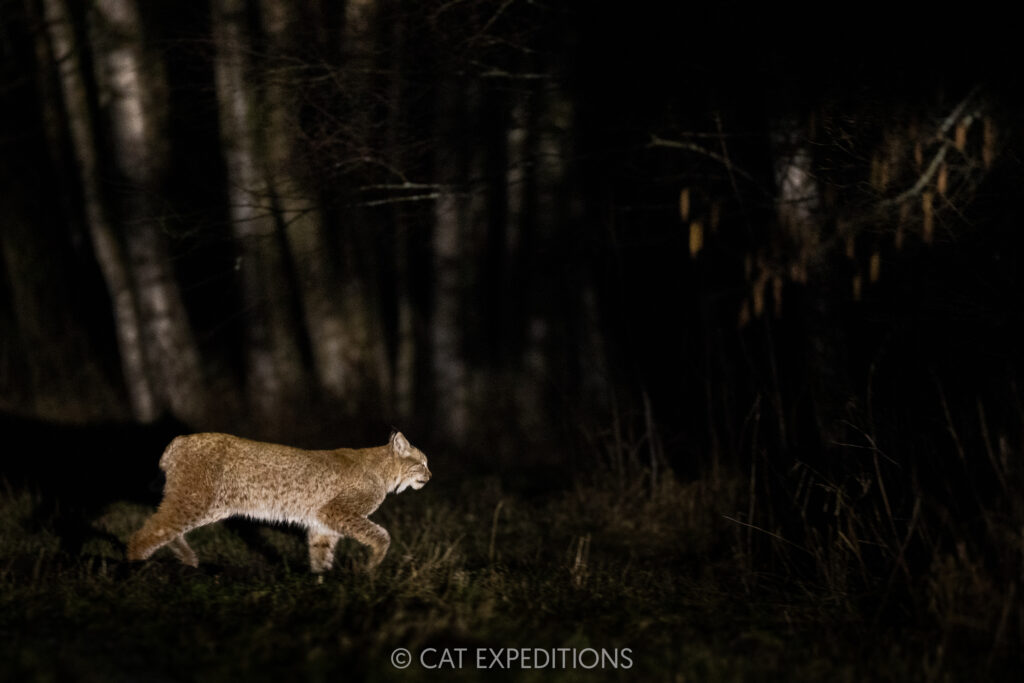
Day 3: We started the morning looking for western capercaillie. After driving for only a few minutes we found our first male. It was very skittish so we didn’t press out luck. The same was the case for the next two birds we saw. No photos, but a very cool bird to see. We then went back to the coast to look for otters, instead seeing whooping swans, mute swans, and common mergansers. The pink granite made the sand a beautifully muted pink as well.
We went out into the field again in the afternoon, trying to have a daytime sighting of a lynx, but we only found roe deer. After dinner, we once again hit the road, finding moose, red fox, Eurasian badger, and two raccoon dogs.
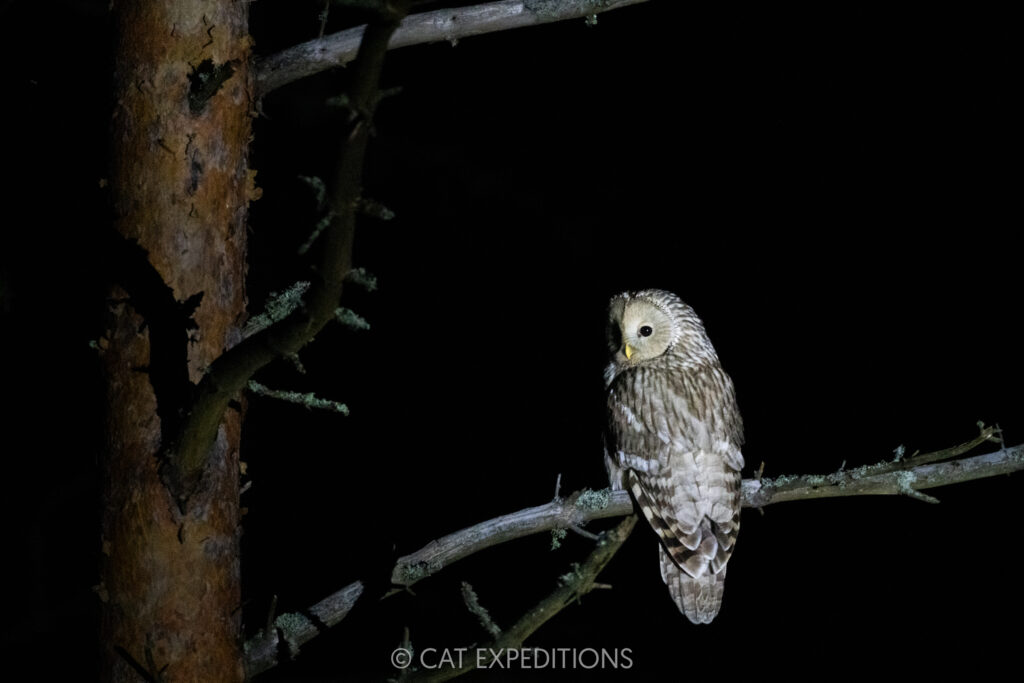
Day 4: Right when we sat down for lunch we heard about a lynx crossing a road nearby. We rushed over, and followed tracks, but they disappeared. Most of the snow had melted the day before. We returned to lunch and spent the remaining afternoon in the area of the lynx crossing, staking out an area we thought the lynx would go to. We split up with our guide, hoping to cover more area. At dusk, we got word from our guide that the lynx had come out of the forest, so we rushed to him, but once again missed the cat by a few seconds. We spent the night in the same area, but never saw the lynx. We did have a great sighting of two moose before returning to the hotel around 1am.
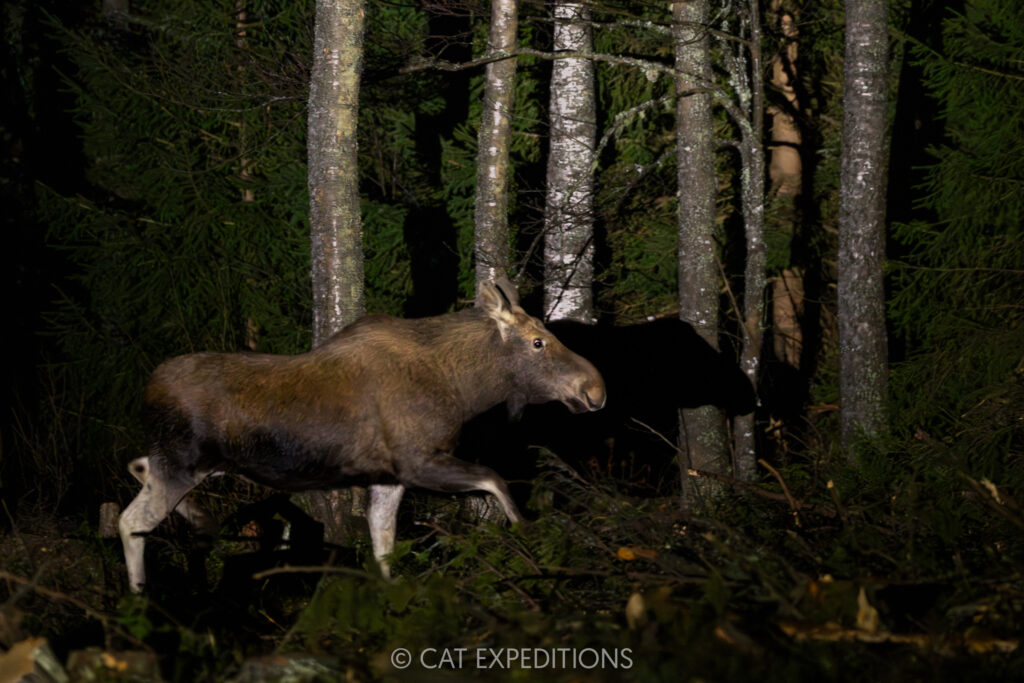
Day 5: The morning was quiet, filled with drizzle. After lunch we returned to the area from the previous day’s afternoon. We found a nice Eurasian pygmy-owl that provided fantastic views.
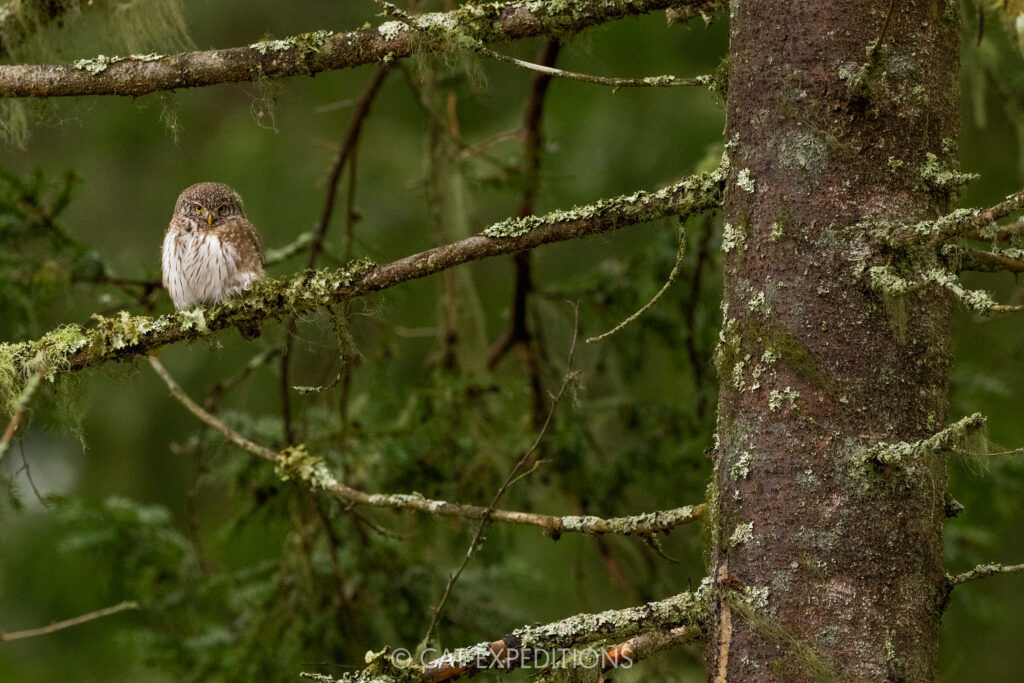
From there, based on the hunch of our local guide, we checked out another area. While driving by people’s (beautiful) old rural houses, one of our guests, Adam, yells out “cat, cat, cat!” We all look and see a large female lynx walking through someone’s front yard. She walked towards and on top of a rock wall, slightly in cover, where she sat down. All of a sudden, she was joined by a kitten, cautiously, yet curiously taking a few steps towards us to check us out. They sat there for about 12 incredible minutes. Then they stepped off the rock pile, walked along the edge of a field, and mom at its very end, stopped, and gave us one last glorious look. We couldn’t believe what we had just witnessed. At the beginning of our trip, our local guide told us there was a five percent chance of a daytime Eurasian lynx sighting. We had just won the lottery, and we knew it. We celebrated over dinner, recounting every second of the sighting. We went out after dinner one more time, and saw some raccoon dogs, but no more lynx for the day.

Day 6: We went out in the morning to look for the mom and cub, so we headed back to the area we had seen her the day before. We searched unsuccessfully in the morning, but had a nice stop at a museum store for postcards, and a delicious lunch. We then also enjoyed a bit of the local culture by utilizing the sauna of our hotel. We had the whole facilities with over three saunas, two hot tubs, a cold plunge, and a pool all to ourselves.
In the afternoon we once again headed back to the same area. We drove up and down the roads around where we had last seen her, but all was quiet. Working together with another spotter we were able to cover more ground. As the sun slowly set, we got a call, they spotted the lynx. We rushed over to find the lynx on the edge of a field, looking at roe deer grazing. Would we see a hunt? Just the possibility of it had us all on edge. We didn’t turn on any light as to not disturb the hunt, watching what unfolded through thermals.
The wind was against the cat’s favor and the roe deer soon got wary. They couldn’t see the cat, but they knew she was there. They were getting more nervous by the second. Since the cat was still over a hundred yards away from them, they were beyond safe, but they didn’t know that.

Then, a mountain hare emerged from the forest on our side. Its pure white coat made it stand out against the snow-less ground. The roe deer noticed it immediately, and with their nervous energy immediately started alarm calling and prancing away in the opposite direction of both the hare and the cat. The female lynx just sat there, seemingly contemplating her options. She decided it was worth stalking the hare.
The field was wide open, and flat, there was no cover for her to hide behind. Nonetheless she approached, body crouched, feet placed carefully as she started her stalk. She was two hundred yards away. Would she really be able to make it to the hare without it noticing? One hundred yards. Fifty yards. She was deliberate in her movements and the hare was none the wiser. Then suddenly, the hare took off, AT the lynx. At twenty yards it changed directions and started moving away from the cat. Her predator instinct kicked in, running after the hare for a few meters. She quickly realized she was still way too far away to give herself any chance of a successful hunt. She stopped and re-engaged her stalk of the hare which had now stopped a hundred yards away.
Seventy yards, fifty yards. Her kitten was now behind her, at first stalking then getting impatient and sitting up. We thought that would give them away, but once again, the hare didn’t realize. Forty yards. Thirty yards. The female would move inches at a time. Maybe the stalk would take another hour, but she wasn’t going to let impatience ruin the hunt. Twenty yards. We hear a noise. It takes us a second to register it is a lynx calling. However, it’s not the mother, nor the kitten.
We scan the field and forest when a third lynx emerges from the far tree line. He calls again. This time, with immediacy, the mother abandons her hunt, gets up, and runs towards her kitten. When she reached her, she nuzzled her and together they both ran right towards the male. What the hell was going on?
Upon reaching the male, the female nuzzled him, the kitten a bit more apprehensive. Then they just sat there, a trio of lynxes, looking out over the field. This continued for another ten minutes before we decided they weren’t going to hunt again and that it was ok for us to approach with a spotlight. We approached carefully; the lynx didn’t move. The mother and kitten were behind some reeds, but it was incredible to see three lynx, especially a male, female, and kitten together. We took a few photos before the cats retreated a few feet into the forest.
Once again, we just couldn’t believe our luck, headed to dinner and just rejoiced over the incredible sighting we had.
Day 7: We decided to go out early to look for the group in the same area. No sign of the lynx there, but it was good to check anyway.
After breakfast we went out with the local guide to do some birding since the guests decided to rest. We saw hazel grouse and skylark and some beautiful parts of the coastline. We looked for black woodpecker but didn’t find any. The occasional bird call would pierce the eerie silence of the forest.
After some editing in the early afternoon, we went back into the field, back to the same spot in the hopes of finding the mom, cub, and male. We found a good spot at the forest edge, sat down, and waited, hoping they would emerge before dark. As dusk turned to night, stars started to show themselves. A Eurasian badger passed by on the thermal. We called off the stake out after an hour after dark, assuming the lynx would have already come by.
After getting back in the car, we found some beavers, then we found the male lynx from the night before, hiding behind a small tree. He was fairly relaxed, so we got out of the car, and photographed him for a little bit on foot. Since he wasn’t as comfortable as we would have liked, we left him, thankful for the bit of time we did have with him. It was a beautiful way to end the trip.
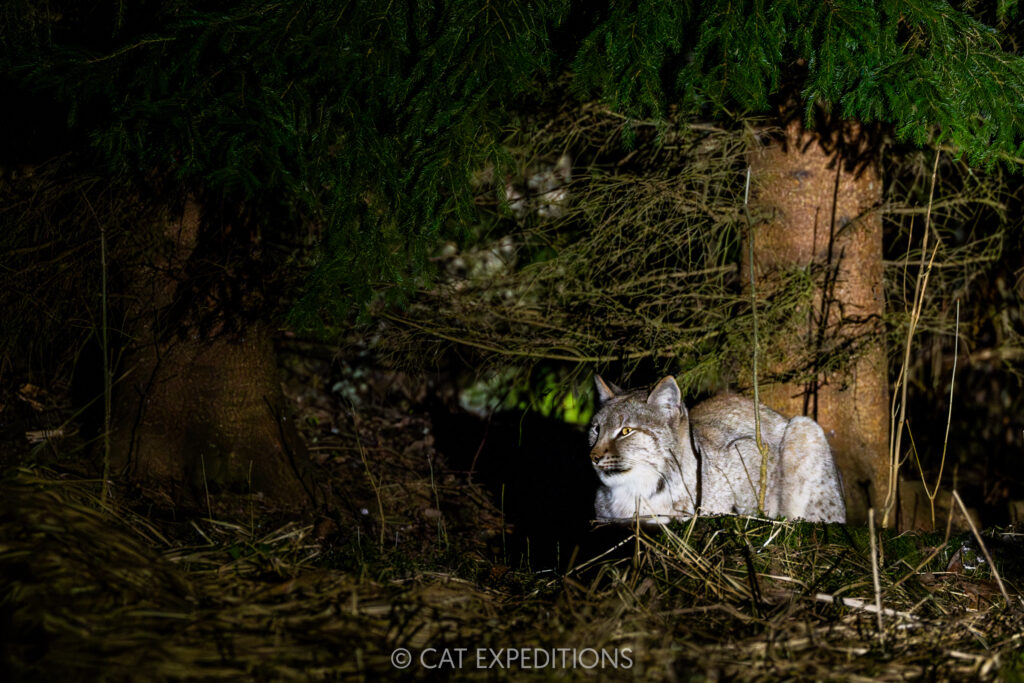
Day 8: It was time to head back to Tallinn for our outbound flight. On the way out, we saw a Red Squirrel, our final and definitely cutest mammal for the trip!
Eurasian Lynx of Estonia Photo Tour 2025 Species List
Mammals
| Eurasian Hare | Lepus europaeus |
| Mountain Hare | Lepus timidus |
| Eurasian Beaver | Castor fiber |
| Red Squirrel | Sciurus vulgaris |
| Eurasian Lynx | Lynx lynx |
| Golden Jackal | Canis aureus |
| Common Raccoon Dog | Nyctereutes procyonoides |
| Red Fox | Vulpes vulpes |
| Eurasian Badger | Meles meles |
| Moose | Alces alces |
| Roe Deer | Capreolus capreolus |
Birds
| Mute Swan | Cygnus olor |
| Whooper Swan | Cygnus cygnus |
| Mallard | Anas platyrhynchos |
| Long-tailed Duck | Clangula hyemalis |
| Common Goldeneye | Bucephala clangula |
| Common Merganser | Mergus merganser |
| Hazel Grouse | Bonasa bonasia |
| Western Capercaillie | Tetrao urogallus |
| Gray Partridge | Perdix perdix |
| Rock Pigeon | Columba livia |
| Northern Lapwing | Vanellus vanellus |
| Common Gull | Larus canus |
| White-tailed Eagle | Haliaeetus albicilla |
| Common Buzzard | Buteo buteo |
| Eurasian Pygmy-Owl | Glaucidium passerinum |
| Ural Owl | Strix uralensis |
| Middle Spotted Woodpecker | Dendrocopos medius |
| White-backed Woodpecker | Dendrocopos leucotos |
| Eurasian Jay | Garrulus glandarius |
| Eurasian Magpie | Pica pica |
| Northern Nutcracker | Nucifraga caryocatactes |
| Eurasian Jackdaw | Corvus monedula |
| Eurasian Skylark | Alauda arvensis |
| Long-tailed Tit | Aegithalos caudatus |
| European Starling | Sturnus vulgaris |
| Eurasian Blackbird | Turdus merula |
| European Greenfinch | Chloris chloris |
